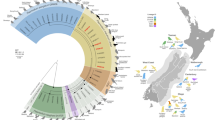Abstract.
Field investigations were carried out over a two-year period in 52 natural watercress beds located in the Limousin region of central France to list the mammal and bird species that frequented these sites. This enabled detection of the definitive hosts of Fasciola hepatica and determination of the prevalence of natural infection in snails. A total of 13 mammal and five bird species were listed in these watercress beds. Adult flukes were found in Lepus capensis (39.2%), Oryctolagus cuniculus (42.0%), and Sylvilagus floridanus (25.0%). No infection with F. hepatica was noted in the five species of rodents studied. Snails infected with F. hepatica were found in 14 watercress beds. The global prevalence of natural infection was 1.1% in Lymnaea truncatula and 0.3% in L. glabra. Among the other trematode larval forms detected, the most frequent was Haplometra cylindracea (0.5%). In the Limousin region, the presence of hares and rabbits in watercress beds ensured the continuation of the F. hepatica life cycle and permitted the subsequent infection of humans when this wild watercress was eaten.
Similar content being viewed by others
Author information
Authors and Affiliations
Additional information
Electronic Publication
Rights and permissions
About this article
Cite this article
Rondelaud, .D., Vignoles, .P., Abrous, .M. et al. The definitive and intermediate hosts of Fasciola hepatica in the natural watercress beds in central France. Parasitol Res 87, 475–478 (2001). https://doi.org/10.1007/s004360100385
Received:
Accepted:
Issue Date:
DOI: https://doi.org/10.1007/s004360100385




